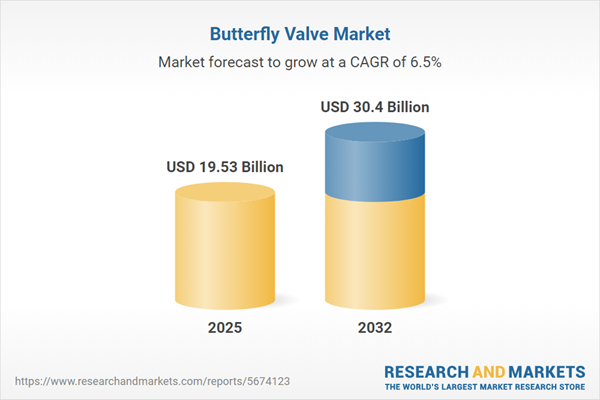Speak directly to the analyst to clarify any post sales queries you may have.
The butterfly valve market is undergoing significant transformation as organizations in highly regulated sectors seek streamlined fluid control, enhanced compliance, and operational agility. Senior decision-makers are targeting solutions that foster modernization, reliability, and responsiveness to shifting regulatory landscapes, addressing both immediate process needs and future-proofing investments.
Market Snapshot: Growth Trajectory in the Butterfly Valve Market
The global butterfly valve market is set to achieve robust expansion, with the market value projected to increase from USD 18.34 billion in 2024 to USD 19.53 billion in 2025, and is anticipated to reach USD 30.40 billion by 2032. This sustained growth is driven by the increasing demand for advanced fluid management technologies and substantial capital flows within power generation, oil and gas, water and wastewater, and chemical industries. Stakeholders are adopting new valve technologies to support facility modernization, enable efficient plant upgrades, and strengthen alignment with dynamic regulatory requirements. Enhanced reliability, operational efficiency, and rapid adaptability to compliance shifts are becoming core purchasing criteria across facility types and regions.
Scope & Segmentation: Key Dimensions Shaping the Butterfly Valve Market
- Application Areas: Critical roles in chemical processing, petrochemical infrastructure, oil and gas networks, power generation, and water treatment ensure compliance and continuous operation.
- Material Types: Materials such as alloy steel, carbon steel, cast iron, and stainless steel are selected for optimal service life, corrosion resistance, and reliability in diverse environments.
- Valve Types: Double flanged, lug, and wafer configurations allow tailored engineering solutions and streamlined integration for both new projects and retrofits.
- Operation Modes: Electric, hydraulic, manual, and pneumatic actuation options support strategies ranging from basic manual systems to advanced automation.
- End Connection Options: Butt weld, flanged, socket weld, and threaded connections ensure easy installation and maintenance adaptation across industrial facilities.
- Size Classes: Industry-standard and custom sizes provide scalability for assets from local utility networks to large-scale industrial operations.
- Geographic Coverage: Markets in the Americas, Europe, Middle East, Africa, and Asia-Pacific reflect varying procurement requirements, with regional compliance and logistics shaping supply chain strategies.
- Leading Companies: Key manufacturers such as Emerson Electric Co., Flowserve Corporation, KSB SE & Co. KGaA, Crane Co., Metso Outotec Oyj, IMI plc, SAMSON AG, Velan Inc., CIRCOR International, Inc., and NIBCO Inc. are advancing performance and reliability standards throughout the sector.
Key Takeaways for Senior Decision-Makers
- Adoption of advanced butterfly valve solutions underpins process stability and regulatory alignment in critical industries where operational continuity is essential.
- Industrial IoT-enabled valves with integrated sensors support predictive maintenance, asset tracking, and improved planning, enhancing uptime and reducing disruptions in plant operations.
- Strategic material selection reduces total lifecycle costs while bolstering compliance and performance in aggressive or variable service environments.
- Sustainable manufacturing practices are increasingly prioritized to support environmental objectives and meet international compliance standards.
- Partnerships between valve producers and automation experts enable seamless system integration, facilitating future-oriented plant modernization and digital optimization.
- Resilient supply chain frameworks, including robust sourcing and dynamic inventory planning, minimize the impact of global logistics shifts and sustain continuous operations.
Tariff Impact: Addressing Supply Chain Pressures and Cost Management
Recent U.S. tariff adjustments have prompted butterfly valve manufacturers to expand domestic production and strengthen ties with local and regional partners. This proactive approach improves cost management and fortifies supply chains against international volatility. Enhanced supplier communication and vigilant market tracking allow organizations to respond quickly to procurement changes and maintain steady input flows, reducing the risk of supply disruptions.
Methodology & Data Sources
This analysis draws on comprehensive secondary research, detailed expert interviews, and a thorough review of technical literature. Established frameworks—such as Porter’s Five Forces and SWOT analysis—are utilized to deliver actionable insights tailored for the operational and strategic demands of the butterfly valve market.
Why This Report Matters: Executive-Level Value for Strategic Planning
- Enables senior leaders to assess, implement, and optimize next-generation fluid control solutions for stringent compliance and robust operational benchmarks.
- Delivers clear, actionable intelligence to support risk mitigation, informed innovation, and continued resilience in regulated sectors adapting to regulatory and market evolution.
- Facilitates agile and data-driven decision-making, empowering teams to maintain flexibility and a strong competitive edge in dynamic market environments.
Conclusion
This market intelligence provides senior executives with strategic guidance for enhancing reliability, optimizing procurement, and achieving operational excellence as regulatory and technological landscapes evolve within the butterfly valve sector.
Additional Product Information:
- Purchase of this report includes 1 year online access with quarterly updates.
- This report can be updated on request. Please contact our Customer Experience team using the Ask a Question widget on our website.
Table of Contents
3. Executive Summary
4. Market Overview
7. Cumulative Impact of Artificial Intelligence 2025
Companies Mentioned
The companies profiled in this Butterfly Valve market report include:- Emerson Electric Co.
- Flowserve Corporation
- KSB SE & Co. KGaA
- Crane Co.
- Metso Outotec Oyj
- IMI PLC
- SAMSON AG
- Velan Inc.
- CIRCOR International, Inc.
- NIBCO Inc.
Table Information
| Report Attribute | Details |
|---|---|
| No. of Pages | 195 |
| Published | November 2025 |
| Forecast Period | 2025 - 2032 |
| Estimated Market Value ( USD | $ 19.53 Billion |
| Forecasted Market Value ( USD | $ 30.4 Billion |
| Compound Annual Growth Rate | 6.5% |
| Regions Covered | Global |
| No. of Companies Mentioned | 11 |









